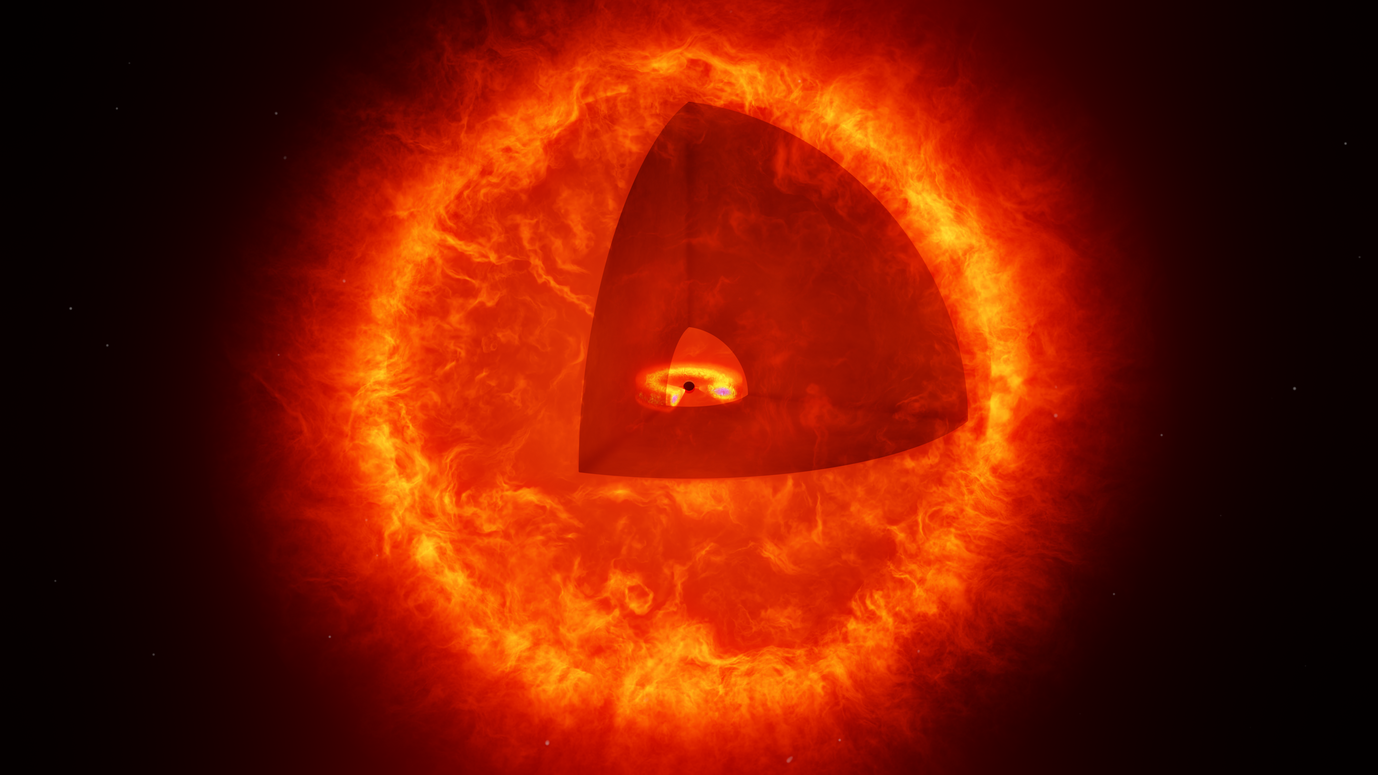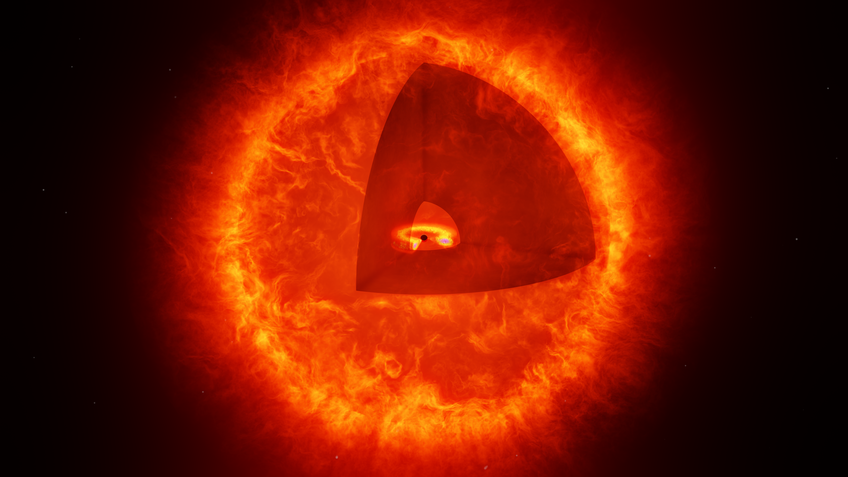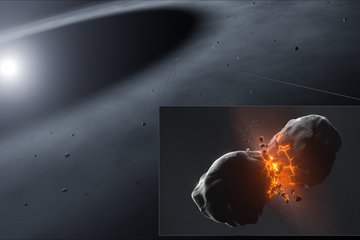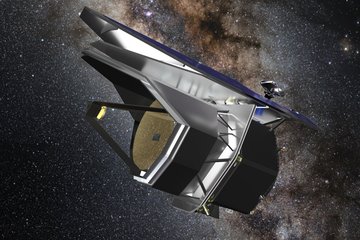“Black Hole Stars” could solve JWST riddle of overly massive early galaxies
A newly discovered distant object that astronomers have dubbed “The Cliff” could solve a riddle posed by some of the first observations of the distant universe with the James Webb Space Telescope, related to the discovery of a population of objects dubbed “little red dots.” Those objects were thought to be young galaxies, but with such considerable mass as would have been difficult to explain in current models of cosmic evolution. “The Cliff” has led to a proposal that could resolve this problem: Little red dots are not galaxies, but instead supermassive black holes that are embedded in a thick envelope of gas. The researchers call this new class of object a “black hole star.”

In the summer of 2022, less than a full month after the James Webb Space Telescope (JWST) had begun to produce its first scientific images, astronomers noticed something unexpected: little red dots. In pictures taken at JWST’s unprecedented sensitivity, these extremely compact, very red celestial objects showed very clearly in the sky, and there appeared to be a considerable number of them. JWST had apparently discovered a whole new population of astronomical objects, which had eluded the Hubble Space Telescope. That latter part is unsurprising. “Very red” is astronomy lingo for objects that emit light predominantly at longer wavelengths. The little red dots emit light predominantly at wavelengths beyond a 10 millionth of a meter, in the mid-infrared. Hubble cannot observe at wavelengths this long. JWST, on the other hand, is designed to cover this range.
Additional data showed that these objects were far away indeed. Even the closest examples were so far away that their light had taken 12 billion years to reach us. Astronomers always look into the past, and we see an object whose light takes 12 billion years to reach us as it was those 12 billion years ago, a mere 1.8 billion years after the Big Bang.
Unexplainable young, massive galaxies?
This is where things get dicey. In order to interpret astronomical observations, you need a model of the object in question. When astronomers point to their data and say, “This is a star,” the statement comes with a lot of baggage. It is trustworthy only because astronomers have robust physical models of what a star is – in short, a giant plasma ball held together by its own gravity, producing energy by nuclear fusion in its centre. You also need a good understanding of how stars look, both in images and in the rainbow-like decomposition of light known as a spectrum. In turn, if you see an object with the right kind of appearance and the right kind of spectrum, you can confidently state that it is a star.
The little red dots did not seem to fit into any of the usual slots, so astronomers set out to look beyond the standard objects. One of the first interpretations offered was a bombshell in and of itself: In this interpretation, little red dots were galaxies that were extremely rich in stars, their light reddened by huge amounts of surrounding dust. Within our own cosmic neighborhood, if you put our solar system in a cube one light-year a side, that cube would only contain a single star: our Sun. In the star-rich galaxies postulated to explain little red dots, a cube that size would contain several hundred thousand stars.
In our home galaxy, the Milky Way, the only region that dense in stars is the central nucleus, but that contains only about one thousandth of the stars needed in those little-red-dot models. The sheer number of stars involved, as high as hundreds of billions of solar masses’ worth less than a billion years after the Big Bang, raised major questions about astronomers’ basic understanding of galaxy evolution: Could we even explain how these galaxies produced so many stars, so quickly? Co-author Bingjie Wang (Penn State University) explains: “The night sky of such a galaxy would be dazzlingly bright. If this interpretation holds, it implies that stars formed through extraordinary processes which have never been observed before.”
Galaxies vs. active galactic nuclei
The interpretation itself remained controversial. The community split into two camps: One group that favored the many-stars-plus-dust interpretation, and another that interpreted little red dots as active galactic nuclei, but also obscured by copious dust. Active galactic nuclei are what we see when a steady stream of matter falls onto a galaxy’s central black hole, forming an exceedingly hot, so-called accretion disk around the central object. But this second interpretation came with its own set of limitations. There are marked differences between the spectra of little red dots and those of the dust-reddened active galactic nuclei astronomers had previously observed. In addition, this interpretation would require extremely large masses for the supermassive black holes at the center of those objects – and surprisingly many of those, given the large number of little red dots that had been found.
There was a consensus, too: that in order to resolve the puzzle, astronomers would need more and different observational data. The original JWST observations had provided images. For testing physical interpretations, astronomers need spectra: detailed information about how much light an object emits at different wavelengths. For the top telescopes, there is considerable competition for observing time. Once it became clear just how interesting little red dots were, numerous astronomers world-wide began to apply for time to observe them more closely. One such application was the RUBIES program formulated by Anna de Graaff at the Max Planck Institute for Astronomy in Heidelberg and an international team of colleagues, where the acronym stands for “Red Unknowns: Bright Infrared Extragalactic Survey.”
The distant treasures of RUBIES
The RUBIES application was successful, and between January and December 2024, the astronomers used nearly 60 hours of JWST time to obtain spectra from a total of 4500 distant galaxies, one of the largest spectroscopic data sets obtained with JWST to date. As Raphael Hviding (MPIA) says: “In that data set, we found 35 little red dots. Most of them had already been found using publicly available JWST images. But the ones that were new turned out to be the most extreme and fascinating objects.” Most interesting of all was the spectrum for an object the astronomers found in July 2024. The astronomers dubbed the object in question “The Cliff,” and it seemed to be an extreme version of the population of little red dots – and by that very fact a promising test case for interpretations of just what little red dots were. The Cliff is so distant from us that its light took 11.9 billion years to reach us (redshift z=3.55).
“The Cliff” gets its name from the most prominent feature of its spectrum: a steep rise in what would be the ultraviolet region, at wavelengths just a little shorter than that of violet visible light. “Would” because our universe is expanding: A direct consequence is that, for an object as distant as The Cliff, that wavelength is stretched to almost five times its original value, landing squarely in the near-infrared (“cosmological redshift”). A prominent rise of this kind, at these wavelengths, is known as a “Balmer break.” Balmer breaks can be found in the spectra of ordinary galaxies, where they are usually seen in galaxies that form little to no new stars at the time. But in those cases, the rise is much less steep than The Cliff.
A curious similarity to single stars
With this unmissable, unusual feature, The Cliff looked like it did not fit any of the interpretations that had been proposed for little red dots. But De Graaff and her colleagues wanted to make sure. They constructed diverse variations of all the models that tried to cast little red dots either as massive star-forming galaxies or as dust-shrouded active galactic nuclei, attempted to reproduce the spectrum of The Cliff with each one, and failed every single time.
Anna de Graaff says: “The extreme properties of The Cliff forced us to go back to the drawing board, and come up with entirely new models.“ By that time, the idea that Balmer-break features in a spectrum might be due to something other than stars had entered the discussion (in the shape of a September 2024 article by two researchers based in China and the UK). De Graaff and her colleagues had started to wonder about something very similar themselves: Balmer breaks can be found both in the spectra of single, very hot, young stars and in the spectra of galaxies containing a sufficient number of such very hot, young stars. Weirdly, The Cliff looked more like the spectrum of a single star than that of a whole galaxy.
Enter black hole stars
On this basis, de Graaff and her colleagues developed a model some of them have taken to calling a “black hole star,” written as BH*: An active galactic nucleus, that is, a supermassive black hole with an accretion disk, but surrounded and reddened not by dust, but by virtue of being embedded in a thick envelope of hydrogen gas. The BH* is not a star in the strict sense, since there is no nuclear fusion reactor in its center. In addition, the gas in the envelope is swirling much more violently (there is much stronger turbulence) than in any ordinary stellar atmosphere. But the basic physics is similar: The active galactic nucleus heats the surrounding gas envelope, just like the nuclear-fusion-driven center of a star heats the star’s outer layers, so the external appearance has marked similarities.
The models formulated by de Graaff and colleagues at this point are proofs-of-concept – pioneering work, but not by any measure a perfect fit. Still, these black hole star models describe the data much better than any other type of model. In particular, the shape of the name-giving cliff in the spectrum is nicely explained by assuming a turbulent, dense, spherical gas envelope around an AGN. From that perspective, The Cliff would be an extreme example where the central black hole star dominates the object’s brightness. For the other little red dots, their light would be a more even mixture of the central black hole star with the light from stars and gas in the surrounding parts of the galaxy.
A new mechanism for rapid early galaxy formation?
If a black hole star is indeed the solution, it might have another potential advantage. Systems of this kind had previously been studied in a purely theoretical setting, with much lighter intermediate-mass black holes. There, the setup with central black hole and surrounding gas envelope was seen as a way for the mass of a very early galaxies’ central black holes growing particularly quickly. Given that JWST has found solid evidence for high-mass black holes in the early universe, a configuration that could explain ultra-fast mass growth of black holes would be a welcome addition to current galaxy evolution models. Whether the supermassive black hole stars can do the same is still undetermined, but it would be an intriguing expansion of their role if they did!
As promising as this sounds, caveats are in order. The new result is brand-new. Reporting on it conforms with accepted practice of covering scientific results once they are published in, or at least accepted by, a peer-reviewed journal. But in order to know whether this becomes a trusted part of astronomy’s view of the universe, we will need to wait at least a few more years.
Open questions
The present result does represent a major step forward: the first model that can explain the unusual shape of The Cliff, the extreme object’s Balmer break. Like any significant step forward, it leads to new, open research questions: How could such a black hole star have formed? How can the unusual gas envelope be sustained over a longer time? (Since the black hole gobbles up surrounding gas, there needs to be a mechanism for “refueling” the envelope.) How do the other features of the spectrum of The Cliff come about?
Answering those questions requires contributions from astrophysical modeling, but it is also set to benefit from further in-depth observation. In fact, de Graaff and her team already have the approval of JWST follow-up observations for little red dots of particular interest, such as The Cliff, scheduled for next year.
These future observations will shed light on whether black hole stars are indeed the explanation for how today’s galaxies came to be what they are. At this point in time, that outcome is an intriguing possibility, but far from certain.
Background information
The results described here have been accepted for publication as A. de Graaff et al., “A remarkable Ruby: Absorption in dense gas, rather than evolved stars, drives the extreme Balmer break of a Little Red Dot at z = 3.5” in the journal Astronomy & Astrophysics. The paper led by Raphael Hviding that presents the full sample of Little Red Dots in the RUBIES data set has been accepted for publication in the same journal,
The MPIA researchers involved are Anna de Graaff, Hans-Walter Rix and Raphael E. Hviding, in collaboration with Gabe Brammer (Cosmic Dawn Center), Jenny Greene (Princeton University), Ivo Labbe (Swinburne University), Rohan Naidu (MIT), Bingjie Wang (Penn State University and Princeton University), and others.












